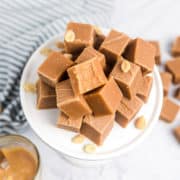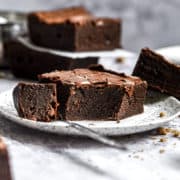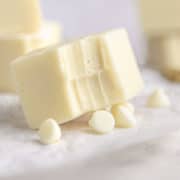Pears offer a decidedly distinctive taste and texture and can be enjoyed fresh or used in a variety of dessert recipes. There are different pear varieties to choose from. It's well worth learning how to store pears so you can keep them fresh and juicy, as well as to stop them from spoiling too quickly.

Jump to:
The soft, grainy texture of a pear makes it a special fruit that most people enjoy. You can buy ripe pears to eat now or unripe pears to ripen for when you're ready, and most grocery stores sell this unique fruit.
One of my favorite recipes for the cooler months is apple turnovers but you could easily substitute pears for the apples. Poached pears are very popular and can be served as a side dish with red meat or for dessert.
You can also add this fruit to smoothies, milkshakes, and other recipes. How about adding a pear to your next mango milkshake?
What are Pears?
Pears (Pyrus Communis) are a fruit with juicy, sweet flesh and a subtly grainy texture. They grow on pear trees and are normally green or yellow-skinned and are mostly round, tapering toward the stalk. Pears offer Vitamins C and K, fiber, potassium, and copper, and they are also rich in antioxidants.
This fruit comes in many different varieties, including Bartlett pears, Asian pears, Comice, winter pears, Bosc, and Anjou pears. Each variety has its own flavor, texture, and characteristics.
Some are better for snacking on (don't forget to eat the skin, as it contains 6 times as many polyphenols as the flesh) while others are suitable for poaching or using in baked desserts. Seckel pears are tart and even slightly bitter. Bartlett, Concorde, and Anjou are especially juicy and you will need napkins to eat them.
How to Choose the Best Pears
Pears are unique in that they ripen the best off the tree. They are harvested before the fruit is completely ripe to stop the flesh from turning too grainy and to keep their peak flavor. A pear ripens on the inside before the outside, which means it might feel firm when squeezed but already be ripe inside. So how do you choose the best pears and know if you have unripe, ripening, or too-ripe fruit when buying them?
The best way to determine ripeness is to use gentle pressure on the neck of the pear and, if it yields a bit, then it's ripe. The stem should be intact. The widest part of the fruit shouldn't be very soft because that means it's over-ripe. However, over-ripe pears are fine for smoothies and so on.

How to Store Pears
If you have overripe pears you will want to use them as soon as possible because they probably won't keep for more than a day without turning mushy. If they're not yet at that stage, read on to discover how to store them for the best results.
- Ripe pears will keep for up to 5 days if you keep them in the refrigerator to slow down the ripening process.
- Not quite ripe pears don't need cold storage. Instead, they should be kept at room temperature, perhaps in a fruit bowl, and checked daily to see how ripe they are.
- You can speed up ripening by placing a ripe apple, ripe banana, or another ripe fruit in the fruit bowl with the pears. The ethylene gas produced will speed up the ripening fruit process.
- Sliced, chopped, or cut pears should be refrigerated in an airtight container or plastic bags, and eaten within 4 days. You can either briefly poach them in liquid or dip them in lime or lemon juice to slow down oxidization, which is when the cut surfaces react with oxygen and turn brown.
- You can also freeze pears. A great way to do this is to rinse, peel and core the fruit, and then either freeze them on parchment paper and then transfer into Ziploc bags, or lightly poach them and freeze them (including the poaching syrup) in airtight containers or freezer-safe bags.
Keep in mind that Bartlett pears turn from green to yellow as they ripen but most other varieties don't change color. For this reason, you should check them daily to make sure they don't become over-ripe too fast.
How to Tell if Pears Are Spoiled
Soft pears can be used in desserts such as crumbles or cobblers, or you can add this tasty fruit to smoothies or soups. If a pear has ripened beyond the over-ripe stage and is spoiled, it won't taste good and could upset your stomach.
A pear that is very shriveled, mushy, and/or has juices leaking out of it is definitely bad. Brown squishy areas on the fruit are another indicator of spoilage.
Although a lightly bruised pear with a few soft spots might not be the best quality, it should be okay to eat as long as there is no mold and you remove the bruised parts of the fruit.
Common Questions
Although this fresh fruit makes a nice snack by itself, there are other recipes you can use them in. Sliced pears can be nice in salads and sandwiches, perhaps paired with deli meat, salad vegetables, and so on. Poach them in wine or syrup, bake them in pies or cakes, or grill them and enjoy them with ice cream.
If you have a lot of pears from the farmers market around harvest time, they make a great snack served with cheese. Actually, pretty much any cheese goes with them, including rich-tasting varieties such as blue cheese which contrast beautifully with the pear sweetness. If pears are your favorite fruit and you also like cheese, this flavor combo is sure to impress you!
Poaching pears means cooking them in liquid, and this can be syrup (water and sugar), red or white wine, or something else. To poach pears, prepare the poaching liquid (I like to use red wine and add sugar, cinnamon sticks, and star anise), and then add peeled whole pears and simmer gently until tender. It's best to use slightly under-ripe pears for this, as you don't want them to get mushy or fall off the stalk.

Interesting Facts
- There are more than 3,000 types of pears including summer and winter varieties. These tree fruits range in size, shape, crispness, and sweetness.
- While Asian pears have been cultivated in China since 1134 BC, European pears were first cultivated in Europe around 1000 BC and they originated in Southeast Asia.
- Fresh pears are really high in fiber, giving you 6g of fiber if you eat a whole one, which is as much as a quarter of your daily requirement depending on the type of pear and size of the fruit.
Knowing how to store pears means you can prepare your fruit for short- or long-term storage and keep it fresh, juicy, and delicious. pears are a popular fruit and there is a huge variety of pears to choose from.














